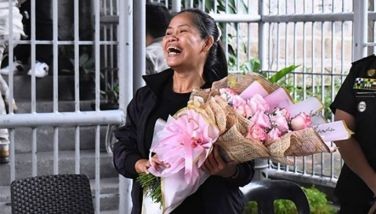Palace backs metrowide curfew for minors

March 1, 2003 | 12:00am
Malacañang backed yesterday a police proposal for a Metro Manila-wide curfew on minors below 18 years old as part of efforts to reduce crime in the metropolis by 20 percent.
So far, of the 17 cities and towns comprising the metropolis, only Manila and Marikina have local ordinances imposing such a curfew.
Presidential spokesman Ignacio Bunye said local governments may pass such ordinances.
Metro Manila police chief Reynaldo Velasco said the crime incidence in Manila and Marikina went down since a curfew was imposed.
"This is a big help in lowering street crimes because of its pre-emptive effects. Minors who are usually out in the streets during late nights are either the usual victims or recruited by syndicates to become criminals," he said.
"We will encourage the local (town and city councils) to pass curfew ordinances in their respective areas to control unnecessary movements by youths," he added.
Velasco was ordered a week ago by President Arroyo to bring down street and petty crime such as cell phone snatching by 20 percent.
The last time a curfew was imposed Metro Manila-wide – on all ages that time – was during the first few years of martial law, declared by President Ferdinand Marcos on Sept. 21, 1972.
A siren would blare the start of the curfew and those found outside their homes were questioned by the police.
Last year Mrs. Arroyo vowed to crack down on crime as part her administration’s efforts to build a "strong republic."
In her State-of-the-Nation Address in July, she said crime undermined the country’s economic recovery efforts and was threatening national security.
Last year, Mrs. Arroyo took to visiting the police and having her picture taken with arrested suspects in kidnapping, drugs and tax fraud cases to boost her get-tough image.
The publicity stunt ensured front-page newspaper treatment for the President.
However, critics said the practice pre-judged suspects who have not yet been convicted of the crime. In court, an accused is presumed innocent until proven guilty beyond reasonable doubt.
Mrs. Arroyo’s policy of publicly parading arrested crime suspects shortly backfired in August when she mistakenly presented a whistleblower in a tax diversion case as a suspect.
She was criticized when she refused to apologize to the whistleblower, bank clerk Acsa Ramirez, for the mistake.
The Philippines has suffered from an image of being unsafe to tourists and investors due to a rash of kidnapping-for-ransom cases and drug-related crimes. Less than two million tourists visit the country each year.
So far, of the 17 cities and towns comprising the metropolis, only Manila and Marikina have local ordinances imposing such a curfew.
Presidential spokesman Ignacio Bunye said local governments may pass such ordinances.
Metro Manila police chief Reynaldo Velasco said the crime incidence in Manila and Marikina went down since a curfew was imposed.
"This is a big help in lowering street crimes because of its pre-emptive effects. Minors who are usually out in the streets during late nights are either the usual victims or recruited by syndicates to become criminals," he said.
"We will encourage the local (town and city councils) to pass curfew ordinances in their respective areas to control unnecessary movements by youths," he added.
Velasco was ordered a week ago by President Arroyo to bring down street and petty crime such as cell phone snatching by 20 percent.
The last time a curfew was imposed Metro Manila-wide – on all ages that time – was during the first few years of martial law, declared by President Ferdinand Marcos on Sept. 21, 1972.
A siren would blare the start of the curfew and those found outside their homes were questioned by the police.
Last year Mrs. Arroyo vowed to crack down on crime as part her administration’s efforts to build a "strong republic."
In her State-of-the-Nation Address in July, she said crime undermined the country’s economic recovery efforts and was threatening national security.
Last year, Mrs. Arroyo took to visiting the police and having her picture taken with arrested suspects in kidnapping, drugs and tax fraud cases to boost her get-tough image.
The publicity stunt ensured front-page newspaper treatment for the President.
However, critics said the practice pre-judged suspects who have not yet been convicted of the crime. In court, an accused is presumed innocent until proven guilty beyond reasonable doubt.
Mrs. Arroyo’s policy of publicly parading arrested crime suspects shortly backfired in August when she mistakenly presented a whistleblower in a tax diversion case as a suspect.
She was criticized when she refused to apologize to the whistleblower, bank clerk Acsa Ramirez, for the mistake.
The Philippines has suffered from an image of being unsafe to tourists and investors due to a rash of kidnapping-for-ransom cases and drug-related crimes. Less than two million tourists visit the country each year.
BrandSpace Articles
<
>
- Latest
- Trending
Trending
Latest






























